#Amar Jawan Jyoti
Explore tagged Tumblr posts
Text
Saluting the Brave: A Tribute to Indian Army Soldiers on Army Day: Col Rajyavardhan Rathore
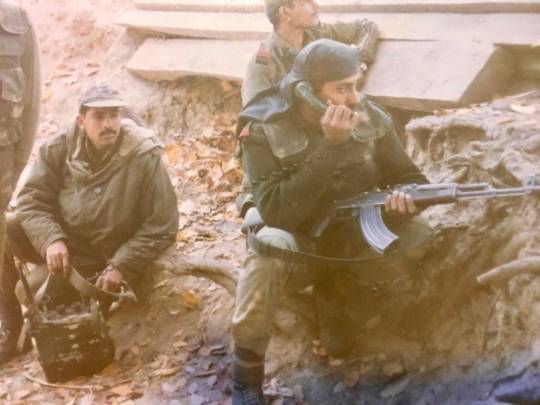
Army Day is a momentous occasion dedicated to honoring the courage, sacrifice, and unwavering dedication of the Indian Army. Observed every year on 15th January, it marks the day in 1949 when Field Marshal K.M. Cariappa took over as the first Indian Commander-in-Chief of the Indian Army from General Sir Francis Butcher. This significant milestone symbolizes India’s sovereignty and self-reliance in defense.
On this Army Day, Colonel Rajyavardhan Rathore, an accomplished soldier, Olympian, and leader, salutes the brave soldiers of the Indian Army. His tribute resonates deeply with every citizen who admires the valor and sacrifices of our armed forces.
The Legacy of the Indian Army
The Indian Army has a proud history steeped in valor and resilience. Whether defending borders, safeguarding internal peace, or aiding civilians during disasters, the Army’s contributions go beyond the battlefield.
Why Army Day Matters
Commemorating Leadership: The day celebrates Indian leadership in the Army, starting with Field Marshal K.M. Cariappa’s appointment.
Honoring Sacrifices: It’s a solemn reminder of the sacrifices made by soldiers who safeguard our sovereignty.
Fostering Patriotism: Events like parades and tributes inspire citizens, especially the youth, to respect and support the armed forces.
Col Rathore’s Message: Saluting the Brave
Colonel Rajyavardhan Rathore, in his message, highlights the following:
Acknowledging Sacrifices: Every soldier, from the snowy peaks of Siachen to the scorching deserts of Rajasthan, works tirelessly, leaving their families behind to protect ours.
Inspiring Unity: The Army symbolizes India’s unity in diversity, with soldiers from every state standing shoulder to shoulder for a common cause.
Recognizing Resilience: Beyond warfare, the Army’s role in disaster management and peacekeeping exemplifies its commitment to the nation.
“The Indian Army’s spirit of courage and commitment is unparalleled, and every citizen owes them respect and gratitude.” — Col Rajyavardhan Rathore
Heroes of the Nation: The Indian Soldier
Indian Army soldiers are known for their admirable qualities:
Courage Under Fire: From Kargil to counter-insurgency operations, Indian soldiers have demonstrated unparalleled bravery.
Discipline and Dedication: Their rigorous training and discipline ensure they’re ready for any challenge.
Compassion: Whether rescuing civilians during floods or supporting local communities, soldiers showcase humanity in action.
Army Day Celebrations
Army Day is marked with enthusiasm and solemnity across the nation.
Key Highlights of the Day:
Parade at Cariappa Parade Ground, Delhi: Showcasing the Army’s modern weaponry and operational capabilities.
Gallantry Awards: Soldiers are honored for acts of bravery in the line of duty.
Tributes to Martyrs: Floral wreaths are laid at the Amar Jawan Jyoti in New Delhi.
The Indian Army’s Role Beyond Borders
The Indian Army is not limited to national defense.
Peacekeeping Missions:
Indian soldiers have been part of various United Nations peacekeeping missions, reflecting India’s commitment to global peace and security.
Disaster Relief Operations:
From the Kerala floods to the Uttarakhand landslides, the Army’s swift action has saved countless lives.
Lessons from the Indian Army
Col Rathore’s tribute underscores the values of the Indian Army that every citizen can adopt:
Duty Before Self: Putting the nation above personal interests.
Unity in Diversity: Embracing differences to work towards a shared goal.
Resilience in Adversity: Facing challenges with strength and determination.
Col Rajyavardhan Rathore: A Soldier’s Perspective
As a former officer of the Indian Army, Col Rathore’s tribute is both heartfelt and informed. His experiences in service highlight the camaraderie, discipline, and sacrifices that define life in the Army.
“The Indian Army is not just a profession; it is a way of life that instills pride, selflessness, and honor,” says Col Rathore, urging every Indian to contribute in their own way to the nation’s progress.
A Nation’s Gratitude
Army Day is not just a celebration; it is an occasion for every citizen to reflect on the immense contributions of the Indian Army. Col Rajyavardhan Rathore’s tribute reminds us of the sacrifices made by soldiers to ensure our safety and freedom.
As we salute the brave on this Army Day, let us commit ourselves to supporting the armed forces and honoring their legacy every day of the year.
Jai Hind!
“A soldier fights not because he hates what is in front of him, but because he loves what is behind him.”
4 notes
·
View notes
Text
Full Day Old and New Delhi Tour by Private Taj Mahal tour Company

Full-Day Old and New Delhi Tour by Private Taj Mahal Tour Company
Delhi, the capital of India, is a mesmerizing blend of historical grandeur and modern sophistication. A Full-Day Old and New Delhi Tour by a Private Taj Mahal Tour Company offers an exclusive, hassle-free, and immersive experience, covering the city's most iconic landmarks.
Whether you're fascinated by Mughal-era monuments, intrigued by British colonial architecture, or excited to explore vibrant markets and spiritual sites, this tour is perfect for first-time visitors and history lovers alike.
Why Choose a Private Full-Day Delhi Tour?
✔ Comfortable Private Car: Travel in an air-conditioned vehicle with a professional driver. ✔ Expert Local Guide: Gain deep insights into Delhi’s rich history and culture. ✔ Customizable Itinerary: Explore at your own pace with a flexible schedule. ✔ Skip-the-Line Access: Avoid long queues at top attractions. ✔ Perfect for Photography: Capture stunning views of Delhi’s heritage and skyline.
What to Expect on a Full-Day Delhi Tour?
1. Hotel Pick-Up and Comfortable Start
Your tour begins with a hotel pick-up from anywhere in Delhi, Noida, or Gurgaon in a private air-conditioned car.
Exploring Old Delhi – The Historic Heart of the City
2. Jama Masjid – India’s Largest Mosque
Begin your journey at Jama Masjid, one of the largest mosques in India. Built by Mughal Emperor Shah Jahan, it can accommodate over 25,000 worshippers. Marvel at its stunning red sandstone and white marble architecture.
3. Rickshaw Ride through Chandni Chowk Market
Hop on a traditional rickshaw and navigate the bustling lanes of Chandni Chowk, one of Delhi’s oldest and busiest markets. Experience vibrant bazaars, delicious street food, and a mix of cultures and traditions.
4. Visit Red Fort – A UNESCO Heritage Site
Admire the majestic Red Fort, a symbol of Mughal power and a UNESCO World Heritage Site. Built in 1648, this red sandstone fortress once housed the Mughal emperors.
5. Raj Ghat – Mahatma Gandhi’s Memorial
Pay homage at Raj Ghat, the serene memorial of Mahatma Gandhi, where he was cremated in 1948. The black marble platform is a place of reflection and peace.
Exploring New Delhi – The Modern Face of the Capital
6. India Gate – The War Memorial
Visit India Gate, a 42-meter-high archway built in memory of Indian soldiers who died in World War I. The eternal flame (Amar Jawan Jyoti) burns in honor of fallen heroes.
7. Rashtrapati Bhavan – The Presidential Residence
Drive past Rashtrapati Bhavan, the official residence of the President of India. This grand building, spread over 330 acres, showcases British and Indian architectural influences.
8. Parliament House and Rajpath Avenue
See the Parliament House, an iconic circular structure that houses India's government. Enjoy a scenic drive along Rajpath, the ceremonial boulevard leading to India Gate.
9. Humayun’s Tomb – A Mughal Masterpiece
Explore Humayun’s Tomb, a UNESCO World Heritage Site and an inspiration for the Taj Mahal. Built in 1570, this stunning garden tomb reflects the grandeur of Mughal architecture.
10. Lotus Temple – The Temple of Peace
Visit the Lotus Temple, an architectural marvel shaped like a blooming lotus. It is a Bahá'í place of worship that welcomes visitors from all faiths.
11. Qutub Minar – The Tallest Brick Minaret in the World
End your tour with a visit to Qutub Minar, a 73-meter-high tower built in the 12th century. This UNESCO-listed monument is a testament to Delhi’s rich history.
Lunch Break – Enjoy Authentic Indian Cuisine
During the tour, stop at a renowned Indian restaurant to savor authentic North Indian delicacies, including butter chicken, biryani, and fresh naan.
Benefits of Booking with a Private Taj Mahal Tour Company
✔ Personalized Experience: Explore at your own pace with no rush. ✔ Luxury and Comfort: Travel in a private air-conditioned car with a professional driver. ✔ Knowledgeable Tour Guide: Gain insights into Delhi’s past and present. ✔ Skip-the-Line Entry: Avoid waiting in long queues. ✔ Door-to-Door Service: Enjoy pick-up and drop-off from your hotel.
Best Time to Visit Delhi for a Full-Day Tour
Winter (October to March): Cool weather, perfect for sightseeing.
Summer (April to June): Hot, but an early morning tour can be comfortable.
Monsoon (July to September): Lush green surroundings, though occasional rain showers may occur.
How to Book a Private Full-Day Delhi Tour?
Choose a Trusted Private Tour Company – Check online reviews and ratings.
Confirm Pick-Up Location & Time – Hotels, airports, or railway stations in Delhi.
Select Your Tour Package – Customize the itinerary based on your interests.
Enjoy a Stress-Free Journey – Experience Delhi’s rich history and vibrant culture with ease.
Conclusion
A Full-Day Old and New Delhi Tour offers the perfect balance of history, culture, and modern attractions. Whether you're a history buff, architecture lover, or food enthusiast, this private tour ensures a seamless, informative, and unforgettable experience. Book with a Private Taj Mahal Tour Company for a luxurious and well-organized trip through India’s dynamic capital.
FAQs
1. How long does the Full-Day Delhi Tour take?
The tour lasts 8-10 hours, covering both Old and New Delhi.
2. What is included in the private Delhi tour package?
Most packages include private transport, a professional guide, entry tickets, and lunch at a top restaurant.
3. Can I customize my Delhi tour itinerary?
Yes! You can add or remove attractions based on your preferences.
4. What should I wear for a Delhi city tour?
Wear comfortable clothes, carry a hat and sunglasses, and wear comfortable walking shoes.
5. Is the Delhi full-day tour worth it?
Absolutely! It’s the best way to explore Delhi’s famous landmarks, blending history, architecture, and culture in a single day.
0 notes
Text
Old and New Delhi Private Tour
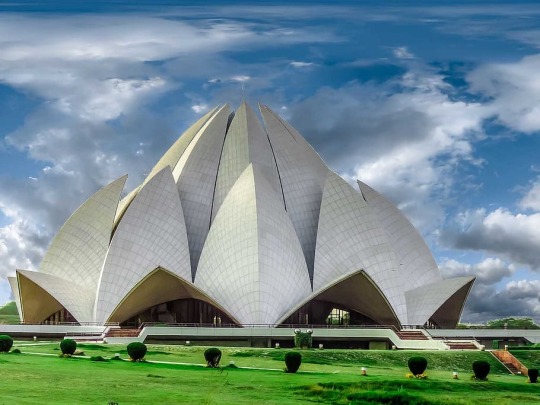
Private Tour of Old and New Delhi: A Trip Through Time India's vibrant capital, Delhi, is an intriguing fusion of historic customs and contemporary energy. Travelers can enjoy a unique experience in Delhi, which is divided into two distinct areas: Old Delhi, which has a rich historical charm, and New Delhi, which has wide avenues and modern architecture. With the help of knowledgeable guides who bring the city's stories to life, you can experience this amazing difference at your own speed with a personalized tour of Old and New Delhi.
What to anticipate from a private tour of Old and New Delhi is covered in full here.
Why Opt for a Private Delhi Tour? You may choose your schedule, get away from crowds, and comfortably see Delhi with a private tour. You can learn more about the history, culture, and way of life of the city when you have an informed guide by your side. Additionally, private transportation makes it easy to navigate the busy streets of Delhi.
Old Delhi: A Look Into the Past Established in the 17th century by the Mughal Emperor Shah Jahan, Old Delhi is a veritable gold mine of historic sites, winding streets, and bustling bazaars.
Lal Qila, or Red Fort The magnificent Red Fort, a UNESCO World Heritage Site, is a great place to start your adventure. For almost 200 years, the Mughal rulers' primary residence was this red sandstone stronghold.
Highlights: Tour the Hall of Public Audience (Diwan-i-Aam) and the Hall of Private Audience (Diwan-i-Khas). Admire the expansive gardens and elaborate Mughal architecture.
Masjid Jama One of the biggest mosques in India, Jama Masjid, is only a short drive from the Red Fort.
Highlights: Admire its enormous courtyard, which can hold 25,000 worshipers. To get a broad perspective of the roofs of Old Delhi, ascend the minaret.
The Chandni Chowk Visit Chandni Chowk to get a taste of the vibrant markets in Old Delhi. This famous bazaar, which sells everything from jewelry to spices, is a sensory experience.
Highlights: Ride a rickshaw through its colorful, winding alleys. Try some of the regional specialties, such as kebabs, jalebis, and parathas.
Ghat, Raj Visit Raj Ghat, the tranquil monument to Mahatma Gandhi, to round up your tour of Old Delhi.
New Delhi: The Contemporary City New Delhi is a representation of grandeur and modernism in sharp contrast to the chaotic charm of Old Delhi. New Delhi, which was created in the early 20th century by British architects Sir Edwin Lutyens and Herbert Baker, is distinguished by its expansive boulevards and green areas.
India Gate The famous India Gate, a military memorial dedicated to Indian soldiers who served in World military I, is a great place to start your tour of New Delhi.
Highlights: Take a stroll along the Rajpath through verdant gardens. See the eternal light honoring dead soldiers, Amar Jawan Jyoti.
The Presidential Residence, Rashtrapati Bhavan Pass Rashtrapati Bhavan, the Indian president's official house. This imposing structure is a masterpiece of architecture.
The Tomb of Humayun Proceed to another UNESCO World Heritage Site, Humayun's Tomb. It is reported that the Taj Mahal's design was influenced by this spectacular building from the Mughal era.
Highlights: Take a leisurely stroll through the exquisitely designed Charbagh gardens. Admire the building with Persian influences and the elaborate stonework.
Temple of the Lotus The Lotus Temple, a Bahá'í House of Worship built like a flowering lotus flower, is a must-see for its distinctive design.
Highlights: Take in the peace and quiet in the prayer hall. Capture pictures of the gorgeous lotus-shaped exterior.
Qutub Minar Visit the Qutub Minar, the world's tallest brick minaret and a UNESCO World Heritage Site, to round off your trip of New Delhi.
Highlights: Take in the Iron Pillar and historic ruins as you explore the Qutub Complex. Discover this wonder of 12th-century Indo-Islamic architecture. Personalizing Your Exclusive Tour
Adaptable Schedule Depending on your interests, private tours let you add or exclude sites. Your guide may tailor the trip to your interests, whether you're a foodie or a history buff.
Convenient Transportation An easy trip is guaranteed when you travel in a private, air-conditioned car, especially in Delhi's congested traffic.
Professional Manuals Your tour is enhanced by an informed guide who shares interesting anecdotes, historical details, and local advice.
Advice for Your Private Tour of Old and New Delhi Put on comfy clothes and shoes. To maximize your day and avoid crowds, get up early. Bring a hat, drink, and sunscreen, especially in the summer. Observe local traditions, particularly when you are in places of worship. Bring a camera so you may document the breathtaking contrasts of Delhi. In conclusion The ideal way to take in the city's rich history and contemporary charm is on a customized tour of Old and New Delhi. You will be mesmerized by Delhi's contrasts, which range from the vibrant Chandni Chowk bazaars to the magnificence of Rashtrapati Bhavan. You may explore this amazing location in luxury and style with a personalized tour, making lifelong memories.
FAQ 1. What is the duration of a private tour of Old and New Delhi? Major sites in both Old and New Delhi are covered in an 8–10 hour full-day trip.
Is it possible to personalize my private tour? Yes, you can customize your schedule to incorporate the things that most interest you with the majority of private tour providers.
What time of year is ideal for travel to Delhi? The months of October through March are the greatest times to go because of the nice weather.
Do private trips include meals? It is contingent upon the tour package. While some offer meals, others provide stops at neighborhood eateries for a genuine dining experience.
Does exploring Delhi require a guide? By navigating crowded areas, giving local insights, and providing historical context, a guide improves your experience.
0 notes
Text
20 Top Places To Visit In Jaipur
Jaipur, the Pink City, is a captivating destination where history, culture, and vibrant energy converge effortlessly for places to visit in Jaipur. With its majestic forts Amer Fort, GovindDevji temple , khazana mahal jaipur ticket price, thikana mandir sri govinddevji Jaipur, sheesh mahal nahargarh fort, amar jawan jyoti Jaipur, Jaipur wax museum, toran dwar jaipur echo stories of the past. There are 20 Top Places To Visit In Jaipur, which provides an unforgettable experience for every traveler. One can also choose 10 top places to visit in Jaipur by browsing our website.
#placestovisitinjaipur#20topplacestovisitinjaipur#10topplacestovisitinjaipur#AmerFort#GovindDevjiTemple#JaipurWaxMuseum#AmarJawanJyoti
0 notes
Text
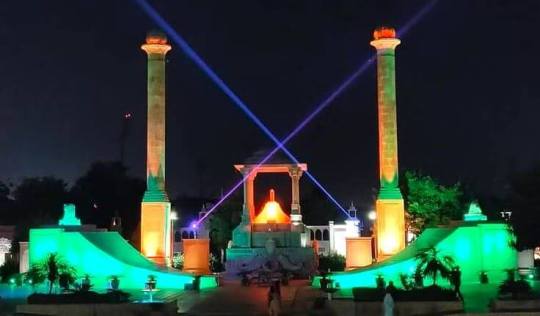
✨ Witness the Eternal Flame of Sacrifice ✨ Amar Jawan Jyoti, Jaipur – a symbol of valor and patriotism that pays tribute to our brave soldiers. Located near the iconic Vidhan Sabha, this war memorial stands as a reminder of the courage and dedication of India’s armed forces.
#amarjawanjyoti#explorejaipur#heritageandhistory#jaipurdiaries#jaipur#pinkcity#incredibleindia#rajasthantourism#travelgoals#travelindia#pinkcityjaipur#travelphotography#jaipurtourism
0 notes
Text
Jaisalmer War Museum: Stories of Valor
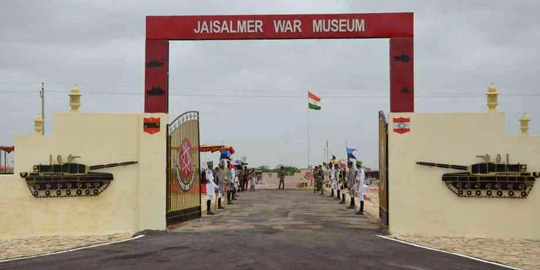
Jaisalmer, known for its golden dunes and magnificent forts, is not only a city of historical grandeur but also one that pays tribute to the bravery of Indian soldiers. Among its many attractions, the Jaisalmer War Museum stands out as a heartfelt homage to the armed forces and their sacrifices. Located on the Jaisalmer-Jodhpur highway, this museum is a must-visit for those exploring the city on a Jaisalmer Sightseeing Tour.
A Tribute to Brave Soldiers
The Jaisalmer War Museum was inaugurated in 2015 to honor the valor of Indian soldiers who defended the country during the wars, especially the 1965 Indo-Pak war and the 1971 Battle of Longewala. It serves as a reminder of the dedication, courage, and sacrifices of the armed forces. If you’re taking a Camel Safari in Jaisalmer, make sure to set aside time to visit this museum, as it adds a historical dimension to your adventure.
Exhibits That Inspire Patriotism
As you step into the Jaisalmer War Museum, the exhibits immediately transport you back in time. The museum features war trophies, vintage equipment, tanks, and captured enemy vehicles. A highlight of the visit is the Longewala Hall, which narrates the heroic tales of the Battle of Longewala through videos and artifacts. The experience is both educational and deeply moving, making it a must-visit spot for history enthusiasts on a Jaisalmer Sightseeing Tour.
The Amar Jawan Jyoti
The Amar Jawan Jyoti, located within the museum premises, is a flame that burns perpetually in memory of the martyrs. It is a solemn place that invites visitors to pay their respects to those who laid down their lives for the nation. When traveling with Marvin Jaisalmer, you’ll find this stop to be an emotional and reflective experience, adding depth to your visit.
Outdoor Displays of Military Equipment
The outdoor section of the Jaisalmer War Museum showcases an array of military equipment, including tanks, artillery guns, and fighter planes. These displays give visitors a glimpse of the might of the Indian armed forces. For those combining their trip with a Camel Safari in Jaisalmer, this museum offers a contrasting yet enriching experience, blending the region’s natural beauty with its military heritage.
Stories of the Battle of Longewala
The Battle of Longewala is a defining moment in Indian military history, and the Jaisalmer War Museum brings it to life. Through detailed accounts, maps, and photographs, visitors can learn about this strategic victory. Many tourists on a Jaisalmer Sightseeing Tour find this section to be one of the most engaging parts of their visit. Marvin Jaisalmer ensures that travelers get ample time to soak in the stories of this battle during their tour.
Interactive Experiences for Visitors
The museum also features interactive exhibits, including audio-visual presentations and guided tours, which make the experience more engaging. These interactive sessions provide insights into the lives of soldiers and the challenges they face. Travelers who combine their museum visit with a Camel Safari in Jaisalmer often appreciate the contrast between the serene desert landscapes and the intense stories of valor shared here.
Ideal for All Age Groups
The Jaisalmer War Museum is suitable for visitors of all ages. Families, students, and history buffs will find something to admire and learn from. For those on a Jaisalmer Sightseeing Tour, this museum is an excellent way to introduce younger generations to India’s rich military history. Marvin Jaisalmer frequently includes this stop in their itineraries, ensuring that visitors get a well-rounded experience of the city.
Combining History and Adventure
Jaisalmer offers a unique blend of history and adventure. While the museum showcases the bravery of soldiers, the Camel Safari in Jaisalmer lets you explore the natural wonders of the desert. This combination of cultural and outdoor experiences makes the city a favorite destination for travelers. Marvin Jaisalmer helps visitors strike the perfect balance between these elements, ensuring a memorable trip.
Practical Information for Visitors
The Jaisalmer War Museum is conveniently located and easy to access. It is open throughout the week, making it a flexible addition to your Jaisalmer Sightseeing Tour. Visitors are advised to allocate at least an hour or two to fully explore the exhibits. Marvin Jaisalmer offers guided tours to ensure you don’t miss any key highlights during your visit.
Conclusion
The Jaisalmer War Museum is more than just a collection of artifacts; it is a powerful tribute to the bravery and sacrifices of Indian soldiers. Whether you’re a history enthusiast or simply curious about the country’s military legacy, this museum is a must-visit. Combine your trip with a Camel Safari in Jaisalmer and a comprehensive Jaisalmer Sightseeing Tour for an unforgettable experience. With Marvin Jaisalmer as your travel partner, you can seamlessly explore the museum and the golden city, creating memories that will last a lifetime.
0 notes
Text
𝗧𝗛𝗘 𝗡𝗔𝗧𝗜𝗢𝗡𝗔𝗟 𝗨𝗡 𝗩𝗢𝗟𝗨𝗡𝗧𝗘𝗘𝗥𝗦 - 𝗜𝗡𝗗𝗜𝗔
ɪᴅᴇᴀꜱ ꜰᴏʀ ɪᴛꜱ ᴄᴇʟᴇʙʀᴀᴛɪᴏɴ ɪɴ ꜱᴄʜᴏᴏʟꜱ
𝗩𝗜𝗝𝗔𝗬 𝗗𝗜𝗪𝗔𝗦
ᴅᴇᴄᴇᴍʙᴇʀ 16
Fifty-three years ago, on December 16, 1971, the Indian Armed Forces achieved a major victory against the Pakistan Army. The war lasted for 13 days and ended on this day with almost 93,000 Pakistani forces surrendering.
It was India’s front that changed the map of South Asia and led to the liberation of a new country, Bangladesh, which was known as East Pakistan before. On this day, which is known as Vijay Diwas, India pays tributes to the brave soldiers who sacrificed their lives during the war.
𝗛𝗶𝘀𝘁𝗼𝗿𝘆
After India gained independence in 1947, Pakistan was divided into two parts – East Pakistan and West Pakistan. Discrimination against the Bengalis in the east, including the disregard for their Bengali language, led to a lot of tensions, which were also fuelled by economic disparities and power imbalances.
In 1970, the Awami League, led by Sheikh Mujibur Rahman, won an election. The Pakistan People’s Party, unwilling to give up power, led to rising tensions. By mid-1971, Bangladesh, formerly East Pakistan, declared independence from Pakistan, triggering violence and forcing many refugees into India.
On March 26, 1971, East Pakistan officially declared their independence and India’s Prime Minister, Indira Gandhi, supported their fight for independence.
The war unfolded as a response to the atrocities in East Pakistan. On December 4, 1971, India initiated Operation Trident, a surprise attack on Karachi port by the Indian Navy’s Western Naval Command. Simultaneously, Mukti Bahini guerrillas joined forces with the Indian military against Pakistani troops.
A crucial turning point occurred on December 14 when the Indian Air Force targeted a meeting in East Pakistan. This move shook Pakistan, initiating the surrender process on December 16, 1971, by the Pakistani Army. This marked the end of the conflict, and Bangladesh emerged as an independent nation. Bangladeshis also celebrate this day and it is known as ‘Bijoy Dibos'
𝗛𝗼𝘄 𝗶𝘀 𝗩𝗶𝗷𝗮𝘆 𝗗𝗶𝘄𝗮𝘀 𝗰𝗲𝗹𝗲𝗯𝗿𝗮𝘁𝗲𝗱?
On 16 December, Vijay Diwas is observed in India. Deeply rooted in respect and remembrance, this day is observed by people in India in different ways.
The day begins with the hoisting of the national flag at half-mast, a sombre acknowledgement of the sacrifices made by the brave soldiers. As the tricolour flutters in the wind, a two-minute silence envelops the country, a moment of reflection to honour the courage and commitment of those who laid down their lives for the greater good.
Veterans are felicitated in various ceremonies held across the nation, their presence a living testament to the resilience and dedication that defined the spirit of 1971. These events serve not only as a mark of gratitude but also as an opportunity for the nation to express its collective appreciation for the sacrifices made by the armed forces.
Central to the Vijay Diwas celebration is the iconic Victory Flame ceremony. The flame, kindled at the National War Memorial in Delhi, symbolises the undying spirit of the Indian Armed Forces. Carried by a relay of uniformed personnel, the flame traverses through different regions of the country, illuminating the path with a message of unity and resolve. The journey culminates in a grand ceremony in the capital, where the flame is ceremoniously merged with the eternal flame at the Amar Jawan Jyoti.
𝗛𝗼𝘄 𝗰𝗮𝗻 𝘆𝗼𝘂 𝗰𝗲𝗹𝗲𝗯𝗿𝗮𝘁𝗲 𝗩𝗶𝗷𝗮𝘆 𝗗𝗶𝘄𝗮𝘀?
On 16th December, Vijay Diwas is observed in different ways across the country. Here are some meaningful ways in which you can celebrate, share gratitude, and raise awareness about its importance.
▪️Sharing Vijay Diwas quotes: Quotes have a remarkable ability to capture the essence of a momentous event or convey profound emotions. On Vijay Diwas, quotes like ‘True heroism is not about trying to outdo everyone at any expense; instead, it’s about the commitment to serving others, regardless of the personal cost’ can inspire individuals to appreciate the bravery displayed during the war. You could share these quotes on social media or use them as part of personal reflections.
▪️Rally the Spirit with Vijay Diwas Slogans: Slogans have the power to echo a collective sentiment. Creating and sharing Vijay Diwas slogans can rally the spirit of unity and patriotism. Slogans like ‘Victory in Unity, Strength in Sacrifice’ or ‘Remembering the Brave, Saluting the Victorious’ can capture the essence of the day. Incorporating these slogans into social media posts, banners, or personal conversations can help spread the significance of Vijay Diwas.
▪️Delivering a speech on Vijay Diwas: Speeches can be a powerful medium to communicate the significance of Vijay Diwas. Whether in schools, community gatherings, or virtual events, delivering a speech on Vijay Diwas which is well-crafted, can educate and inspire. The speech can touch upon the historical context, the sacrifices made, and the enduring impact of the victory. It’s an opportunity to instil a sense of pride and appreciation for the nation’s history.
▪️Sharing ‘Happy Vijay Diwas’ messages and statuses: While the day commemorates a historic victory achieved through sacrifice, it’s also an opportunity to acknowledge the joy of freedom. Sharing ‘Happy Vijay Diwas’ messages can be a way to share positivity while remembering the achievements of the past. Whether in person, through messages, or on social media, spreading happiness on this day reinforces the idea that freedom is worth celebrating.
▪️Through social media: You can create and participate in social media campaigns dedicated to Vijay Diwas. Encourage users to share their thoughts, stories, or tributes related to the day. Utilise popular hashtags such as #VijayDiwas or #SaluteToSoldiers to amplify the reach of your posts. Engaging visuals, such as images of the Victory Flame ceremony or historical photographs, can add depth to the campaign.
▪️Educational Content Creation: Individuals with skills in content creation, such as blogging, podcasting, or video production, can contribute by developing informative and engaging content about Vijay Diwas. This content can be shared across platforms to reach a diverse audience and promote a deeper understanding of the historical context.
▪️Virtual Remembrance: Given the global nature of online platforms, organising virtual remembrance events, where people from different parts of the world can come together to share their thoughts and messages, can be a unique way to foster a sense of global unity in commemorating Vijay Diwas.
▪️Cultural Exchanges: Facilitating cultural exchanges with Bangladesh can be a meaningful way to reinforce the bonds established during the liberation of Bangladesh. Such exchanges can include art exhibitions, joint celebrations, and collaborative projects that celebrate the shared history and cultural ties between the two nations.
▪️Educational Programs: While this is not a celebration, children’s school curriculum should include the history of Vijay Diwas, 1971 War between India and Pakistan and its consequences so that future generations are aware of the sacrifices made during that period. Educational programs, documentaries, and interactive learning modules can make the history of Vijay Diwas accessible and engaging for students.
𝗦𝗶𝗴𝗻𝗶𝗳𝗶𝗰𝗮𝗻𝗰𝗲 𝗼𝗳 𝗩𝗶𝗷𝗮𝘆 𝗗𝗶𝘄𝗮𝘀:
Vijay Diwas, celebrated on 16th December, is a significant milestone in the history of the Indian subcontinent, symbolising not just a military victory but a triumph of justice, unity, and humanitarian values. The profound importance of this day resonates through several key aspects that have left an enduring impact on the collective consciousness.
▪️Triumph of Justice: Vijay Diwas is inseparably linked to the call for justice and human rights during the Bangladesh Liberation War. The conflict arose from the mistreatment of East Pakistan by West Pakistan, and the intervention by the Indian Armed Forces was a resolute response to rectify these injustices. The day marks the triumph of justice over oppression, where the courage and commitment of the armed forces became a beacon of hope for those yearning for freedom.
▪️National Unity: The Indo-Pakistani War of 1971, culminating in Vijay Diwas, showcased the strength of national unity. The armed forces, despite facing formidable challenges, operated with a shared purpose, and the support of the people further fortified their resolve. The victory was not merely a military one; it was a testament to the power of a united nation standing resolutely against injustice.
▪️Humanitarian Impact: The creation of Bangladesh emerged as a beacon of hope and a new beginning for millions who had suffered under oppressive rule. The conflict had displaced countless individuals, and the emergence of a new nation offered the promise of freedom and a chance to rebuild shattered lives.
The humanitarian impact of Vijay Diwas is embedded in the stories of ordinary people who, despite enduring immense hardships, found renewed hope in the liberation of Bangladesh. It underscores the positive repercussions that arise from collective efforts in times of crisis. The conflict was not just about territorial gains; it was a mission to restore human dignity and pave the way for a better future.
The significance of Vijay Diwas, therefore, extends far beyond the military sphere. It represents a shared commitment to justice, a collective stand for human rights, and a testament to the resilience of nations in the face of adversity. As the nation observes Vijay Diwas each year, it is not merely a commemoration of a historical event; it is a reaffirmation of the values that bind us together — the pursuit of justice, the strength of unity, and the enduring spirit of human.
𝗙𝗮𝗰𝘁𝘀 𝗮𝗯𝗼𝘂𝘁 𝗩𝗶𝗷𝗮𝘆 𝗗𝗶𝘄𝗮𝘀:
Liberation of Bangladesh: The primary outcome of the Indo-Pakistani War of 1971 was the liberation of Bangladesh. The victory of the Indian Armed Forces led to the creation of an independent nation.
▪️Surrender at Dhaka: One of the most significant moments of the war was the surrender of the Pakistani forces in Dhaka on December 16, 1971, which marked the formal conclusion of the conflict.
▪️Numerical Supremacy: The Indo-Pakistani War of 1971 showcased the strategic prowess of the Indian Armed Forces, who achieved victory despite being numerically outnumbered.
▪️Humanitarian Impact: Beyond the military aspect, the war had a profound humanitarian impact. The conflict led to millions being displaced, and the subsequent creation of Bangladesh offered a new beginning for the people of the region.
𝗖𝗼𝗻𝗰𝗹𝘂𝘀𝗶𝗼𝗻:
Celebrated on 16th December, Vijay Diwas stands as a testament to the unwavering spirit of justice, unity, and humanitarian values that define the history of the Indian subcontinent. The commemoration of this day serves as a reminder of the sacrifices made by brave soldiers who fought not only for territorial gains but, more significantly, for the principles of justice and human rights.
The historical context leading to the 1971 Indo-Pakistani War reflects the deep-seated injustices and disparities that sparked a quest for independence in Bangladesh. The conflict, fueled by the commitment of the Indian Armed Forces and the Mukti Bahini, culminated in the surrender of the Pakistani forces in Dhaka. This victory celebrated as Vijay Diwas in India and ‘Bijoy Dibos’ in Bangladesh, ushered in a new era of freedom and hope for millions who had endured oppression.
As the nation observes Vijay Diwas each year, it is not merely a historical commemoration but a reaffirmation of shared values. It is a call to remember the resilience of nations in the face of adversity, the pursuit of justice, and the enduring spirit of humanity. The day prompts us to reflect on the sacrifices made and express gratitude to our brave forces, who have dedicated their lives to keep our country safe.

0 notes
Text
Exploring the Best Places in Delhi: A Guide to the Heart of India
Delhi, the capital of India, is a city that beautifully blends history, culture, and modernity. From its bustling markets to awe-inspiring monuments, Delhi offers something for every traveler. Here’s a guide to the best places in Delhi that should be on your must-visit list.
1. Red Fort (Lal Qila)
A UNESCO World Heritage Site, the Red Fort is a symbol of India’s rich history and architectural brilliance. Built by Emperor Shah Jahan in the 17th century, this iconic structure is an epitome of Mughal grandeur.
Highlights:
Light and sound show in the evening
Intricate Mughal architecture
A glimpse into India’s Independence Day celebrations
2. India Gate
Standing as a tribute to Indian soldiers, the India Gate is a war memorial and one of Delhi’s most iconic landmarks. Its sprawling lawns are perfect for picnics and evening strolls.
Highlights:
Night illumination
Amar Jawan Jyoti flame
Boat rides in nearby canals
3. Qutub Minar
Another UNESCO World Heritage Site, Qutub Minar is the tallest brick minaret in the world. It is surrounded by historical ruins and the famous Iron Pillar, which is known for its rust-resistant composition.
Highlights:
Stunning Indo-Islamic architecture
Qutub Festival (held annually)
Archaeological Park nearby
4. Lotus Temple
An architectural marvel, the Lotus Temple is a Baháʼí House of Worship that stands out for its flower-like structure. Open to people of all religions, it’s a serene space for meditation and peace.
Highlights:
Unique lotus-shaped design
Peaceful atmosphere
Beautifully landscaped gardens
5. Chandni Chowk
Dive into the chaotic charm of Chandni Chowk, one of Delhi’s oldest markets. From traditional textiles to delicious street food, it’s a paradise for shopaholics and foodies.
Highlights:
Paranthe Wali Gali
Jama Masjid nearby
Narrow lanes filled with spices, jewelry, and souvenirs
6. Humayun’s Tomb
Often considered a precursor to the Taj Mahal, Humayun’s Tomb is a masterpiece of Mughal architecture. Its sprawling gardens and intricate design make it a favorite among history and architecture enthusiasts.
Highlights:
Persian-style charbagh gardens
Tombs of other Mughal royals
A peaceful retreat from the city’s chaos
7. Akshardham Temple
A modern architectural marvel, Akshardham Temple showcases the grandeur of Indian culture and spirituality. The temple complex features exhibitions, musical fountains, and a boat ride narrating India’s history.
Highlights:
Intricate carvings and sculptures
Musical fountain show
Yagnapurush Kund
8. Hauz Khas Village
Hauz Khas Village blends history with contemporary culture. With its medieval ruins, vibrant cafes, and art galleries, it’s a popular spot for young travelers and art enthusiasts.
Highlights:
Historical Hauz Khas Fort
Bohemian cafes and boutiques
A lively nightlife scene
9. Lodi Gardens
For a tranquil escape, Lodi Gardens offers lush greenery and historical tombs from the Lodi dynasty. It’s perfect for morning walks, picnics, or photography.
Highlights:
Architectural beauty of tombs
Peaceful environment
Ideal spot for fitness enthusiasts
10. Connaught Place (CP)
The heart of Delhi, CP is a hub of shopping, dining, and entertainment. Its circular structure houses a mix of high-end brands, local shops, and iconic eateries.
Highlights:
Janpath Market for budget shopping
Central Park for leisure
Iconic restaurants like Wenger’s and Keventers
Delhi is more than just a city—it’s an experience. Whether you’re a history buff, foodie, or shopaholic, Delhi’s diverse offerings ensure there’s never a dull moment. So pack your bags and immerse yourself in the magic of this vibrant metropolis!
0 notes
Text
India Gate: A Must-Visit Landmark in Delhi | Complete Travel Guide
If you're planning to visit India and explore its rich history, don't miss India Gate in New Delhi. This iconic monument, designed by Sir Edwin Lutyens, is a war memorial dedicated to the soldiers who sacrificed their lives during World War I. Standing tall at 42 meters, India Gate also features the Amar Jawan Jyoti, honoring the soldiers of the Indo-Pak War of 1971. Located on Rajpath, India Gate is not just a symbol of India's freedom but also a major tourist attraction. For full details, visit my blog. Explore the countless wonders India has to offer—history, culture, and breathtaking monuments are waiting for you!
Thinking about visiting India? Don’t miss this stunning landmark and explore many more incredible destinations across India.
Ready to explore India? India is filled with countless landmarks, rich history, and stunning destinations. Plan your journey now and discover the wonders of India's incredible cultural heritage!
Best places to visit in India,Top tourist attractions in Delhi,India travel guide, tourists,Historical landmarks in India,Famous war memorials in India, Planning a trip to India,Travel to India from Paris,Iconic monuments in New Delhi,India cultural and historical sites,Discover India’s rich history, Must-see landmarks in India,
#Visit India#travel india#india#india trip#travel guide#vacation#tourism#explore#Best places to visit in India
0 notes
Text
Delhi Sightseeing Tour
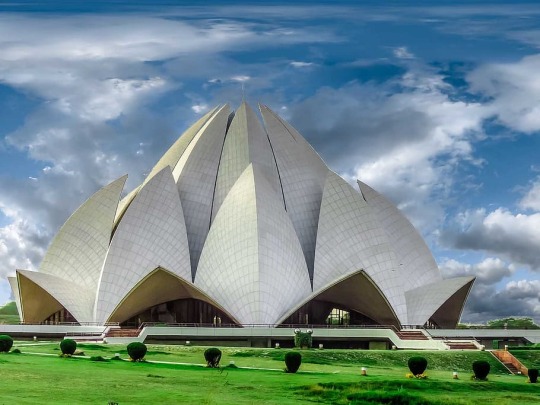
Delhi Sightseeing Tour: Discovering the India's Heart
The energetic capital of India, Delhi, is a city where modernism and history coexist peacefully. Delhi, with its rich centuries-spanning cultural legacy, presents a varied spectrum of experiences from historic sites to busy markets and contemporary marvels. A Delhi sightseeing trip offers a chance to fully experience the modern vitality of the city while also exploring its intriguing past.
This post will walk you through a flawless one-day Delhi sightseeing trip itinerary including the must-see sites and secret jewels defining this famous city.
1. India Gate: Honours Courageous Soldiers Starting from one of Delhi's most well-known sites, India Gate, your sightseeing trip might Constructed as a tribute to the men lost in World War I, this massive 42-meter-high arch stands as a national pride emblem. Particularly in the early morning when the air is clear, the verdant grass around India Gate attract both residents and visitors.
Remember to stroll around the Amar Jawan Jyoti, an everlasting light burning in remembrance of the unknown troops. The sight of India Gate before sunrise is particularly breathtaking, offering a calm start to your journey.
2. Rashtrapati Bhavan: The Presidential Palace Just a short drive from India Gate stands Rashtrapati Bhavan, the official house of the President of India. This huge house, with its expansive grounds and spectacular architecture, is a must-see for those interested in colonial history. Designed by Sir Edwin Lutyens, the edifice exhibits the grandeur of British colonial architecture combined with Indian influences.
While the interior of the palace is not always open to the public, you can tour the Mughal Gardens during specific months and enjoy the well-manicured lawns, blossoming flowers, and quiet environment.
3. Humayun’s Tomb: A UNESCO World Heritage Site Next, proceed to Humayun’s Tomb, a UNESCO World Heritage Site and one of the best specimens of Mughal architecture. This exquisite monument, built in the 16th century, is frequently considered a predecessor to the Taj Mahal due to its comparable style. Surrounded by rich gardens, the tomb stands as a tribute to Mughal creativity and architectural skill.
Wander through the Charbagh (four gardens) arrangement, a typical Persian-style garden design, and see the magnificent symmetry of the tomb. The beautiful craftsmanship on the red sandstone facade, paired with the tranquil surroundings, makes this a must-visit stop on any Delhi sightseeing tour.
4. Qutub Minar: A Marvel of Ancient Engineering Another highlight of your journey is the renowned Qutub Minar, the tallest brick minaret in the world, standing at 73 meters. This UNESCO World Heritage Site is a spectacular example of Indo-Islamic architecture, created in 1193 by Qutb-ud-din Aibak.
The complex around the Qutub Minar includes other historical structures, such as the Quwwat-ul-Islam Mosque and the Iron Pillar, which has stood rust-free for over a thousand years. The Qutub complex is a fascinating peek into India’s medieval history and offers plenty of photo opportunities.
5. Lotus Temple: A Symbol of Unity For a modern architectural marvel, explore the Lotus Temple, noted for its unusual flower-like design. This Bahá'í House of Worship is open to individuals of all faiths and provides a calm environment for meditation and reflection. The temple’s remarkable architecture, with 27 white marble petals, makes it one of the most photographed monuments in Delhi.
Surrounded by beautifully landscaped gardens, the Lotus Temple offers a calm respite from the rush and bustle of the city. It’s a wonderful site for anyone seeking some spiritual serenity during their Delhi sightseeing tour.
6. Red Fort: A Glimpse into Mughal Glory No tour of Delhi is complete without visiting the Red Fort. This UNESCO World Heritage Site was the royal home of Mughal monarchs for approximately 200 years. Built by Emperor Shah Jahan in 1648, the fort is an architectural wonder made of red sandstone. The fort’s huge walls and exquisite palaces are a testimony to Mughal splendour.
Take a trip around Diwan-i-Aam (Hall of Public Audience) and Diwan-i-Khas (Hall of Private Audience), where the emperor previously held court. If you visit in the evening, don’t miss the sound and light display, which brings the fort’s history to life.
7. Jama Masjid: India’s Largest Mosque Just a short distance from the Red Fort is Jama Masjid, India’s largest mosque and another architectural masterpiece erected by Shah Jahan. With its majestic domes and tall minarets, Jama Masjid can house up to 25,000 worshippers at once. The mosque’s magnificent courtyard affords a panoramic perspective of Old Delhi, making it a perfect site for photography.
Visitors are encouraged to tour the mosque’s stunning interiors and enjoy the unique Mughal-era craftsmanship. However, bear in mind that it is a place of worship, so dress modestly and be respectful of the religious customs.
8. Chandni Chowk: A Shopper’s Paradise After seeing the ancient landmarks, immerse yourself in the frenetic energy of Chandni Chowk, one of Delhi’s oldest and biggest markets. This bustling region is a sensory explosion, replete with the sights, sounds, and scents of traditional Indian bazaars. From street food sellers selling chaat and parathas to shops offering textiles, jewelry, spices, and gadgets, Chandni Chowk has it all.
If you’re feeling daring, take a rickshaw ride through the small aisles of the market. It’s an encounter that delivers a true taste of Old Delhi’s tumultuous appeal.
Conclusion A Delhi sightseeing trip is a voyage through time, affording a glimpse into India’s magnificent past while embracing the modernity of today. From the towering monuments of the Mughal era to bustling bazaars and quiet temples, Delhi has something for everyone. Whether you’re a history buff, a shopaholic, or simply looking to experience a dynamic city, Delhi never disappoints.
FAQs 1. How long does a typical Delhi sightseeing trip last? A normal Delhi sightseeing tour lasts a full day, usually around 8 to 10 hours, depending on how many attractions you choose to visit.
2. Is it required to hire a guide for Delhi sightseeing? While it’s not necessary, having a guide can enhance your experience, providing historical context and intriguing details about the landmarks.
3. What is the ideal time to visit Delhi for sightseeing? The greatest time to visit Delhi is during the winter months, from October to March, when the weather is mild and excellent for outdoor activities.
4. Are there any entrance fees for the historical monuments? Yes, most of Delhi’s ancient landmarks, such as the Red Fort, Humayun’s Tomb, and Qutub Minar, have entrance fees. Foreign tourists frequently pay higher rates than Indian ones.
5. What are some must-try local dishes on the tour? Don’t miss out on Delhi’s famous street food like chaat, parathas, and jalebi. If you’re visiting Chandni Chowk, eat the food at Paranthe Wali Gali or savour classic Mughlai delicacies in the adjacent restaurants.
0 notes
Text
Full Day Old and New Delhi Tour by Private Taj Mahal tour Company

Delhi, the heart of India, is a city of contrasts where the ancient and modern coexist beautifully. A Full Day Old and New Delhi Tour by a Private Taj Mahal Tour Company offers an unforgettable journey through time—taking you from Mughal-era forts and bustling markets to colonial landmarks and modern marvels. With a private guide and luxury transport, this tour ensures a comfortable, informative, and hassle-free experience.
Why Choose a Private Delhi Tour?
A private tour offers many advantages, including:
Personalized Experience – Explore at your own pace with a private guide.
Luxury Transportation – Comfortable, air-conditioned vehicle with a professional driver.
Skip-the-Line Access – Save time at major attractions.
Deep Cultural Insights – Learn about Delhi’s history, traditions, and architecture.
Safety & Convenience – Ideal for solo travelers, families, and senior citizens.
Full-Day Old and New Delhi Tour Itinerary
1. Hotel Pickup & Introduction to Delhi
Your private driver and guide will pick you up from your hotel, airport, or any preferred location in Delhi, Noida, or Gurugram. After a brief introduction, your journey through Delhi’s rich history and vibrant culture begins!
Exploring Old Delhi: The Mughal Legacy
2. Jama Masjid: India’s Largest Mosque
Start your day at the stunning Jama Masjid, built by Mughal Emperor Shah Jahan in 1656.
Marvel at the red sandstone and white marble architecture.
Climb the minaret for breathtaking panoramic views of Old Delhi.
Experience the spiritual and cultural essence of the mosque.
3. Rickshaw Ride in Chandni Chowk: The Old Delhi Market
Take an exciting rickshaw ride through the bustling lanes of Chandni Chowk, one of Delhi’s oldest markets.
Visit Khari Baoli, Asia’s largest spice market.
Explore Paranthe Wali Gali, famous for its stuffed parathas.
Experience the vibrant chaos and rich aroma of Indian street food.
4. Red Fort: The Symbol of Mughal Power
Next, visit the magnificent Red Fort, a UNESCO World Heritage Site. Built in 1639, this red sandstone fortress was the main residence of the Mughal emperors.
Explore the Diwan-i-Aam (Hall of Public Audience).
Visit the Diwan-i-Khas (Hall of Private Audience), where the famous Peacock Throne once stood.
Learn about the British invasion and India’s independence struggle.
5. Raj Ghat: Tribute to Mahatma Gandhi
A serene and important stop, Raj Ghat is the memorial of Mahatma Gandhi.
Walk through the peaceful gardens and pay your respects.
Learn about Gandhi’s role in India’s freedom movement.
Exploring New Delhi: The British & Modern Era
6. India Gate: The War Memorial
Drive to India Gate, a 42-meter-high war memorial built to honor Indian soldiers who died in World War I.
Stroll around the beautifully landscaped gardens.
Witness the Amar Jawan Jyoti (Flame of the Immortal Soldier).
Capture stunning photos of this iconic landmark.
7. Rashtrapati Bhavan: The President’s House
Drive past Rashtrapati Bhavan, the official residence of the President of India.
Admire the grand colonial architecture of Lutyens’ Delhi.
Learn about the British influence on modern Delhi.
Stop for a quick photo at the Parliament House.
8. Humayun’s Tomb: The Inspiration for the Taj Mahal
Visit Humayun’s Tomb, a UNESCO World Heritage Site built in 1570. This stunning monument is considered the architectural inspiration for the Taj Mahal.
Marvel at the Persian-style gardens and grand domes.
Discover the intricate Mughal architecture.
Enjoy the peaceful atmosphere away from the city’s chaos.
9. Lotus Temple: The Bahá'í House of Worship
Next, visit the famous Lotus Temple, known for its stunning flower-like structure.
Experience spiritual tranquility in this open-to-all place of worship.
Admire the unique modern architecture of this award-winning monument.
Learn about the Bahá'í faith’s teachings on unity and peace.
10. Qutub Minar: The World’s Tallest Brick Minaret
Conclude your tour at Qutub Minar, a UNESCO-listed monument that stands 73 meters high.
Explore the ruins of the Qutub Complex, including the Iron Pillar.
Learn about Delhi’s early Islamic rulers.
Capture stunning sunset views of this historic site.
Optional Add-Ons: Customize Your Tour
If time permits, you can add:
Akshardham Temple – The largest Hindu temple in the world.
Gurudwara Bangla Sahib – A significant Sikh place of worship.
Dilli Haat – A lively market for handicrafts and traditional food.
11. Drop-Off at Your Hotel
After an enriching day exploring Old and New Delhi, your driver will drop you back at your hotel or preferred location.
Why Book a Full-Day Delhi Tour with a Private Tour Company?
Expert Local Guides – Get deep historical insights.
Luxury Transport – Travel in a comfortable, air-conditioned car.
Tailored Experience – Customize your itinerary.
Skip-the-Line Access – No waiting at crowded attractions.
Trusted & Reliable Service – Safe, secure, and professional tour.
Best Time to Visit Delhi
October to March – Pleasant weather and ideal for sightseeing.
Early Morning or Late Afternoon – Best for comfortable exploration.
Avoid Extreme Summer Months (May-June) – Hot temperatures.
Conclusion
A Full-Day Old and New Delhi Tour by a Private Taj Mahal Tour Company is the perfect way to experience the historical richness, cultural diversity, and modern charm of India’s capital. Whether you’re a history enthusiast, culture lover, or first-time traveler, this tour provides a comprehensive and unforgettable Delhi experience.
FAQs
1. How long does the Full-Day Delhi Tour take? The tour lasts around 8–10 hours, covering all major attractions.
2. Can I customize my itinerary? Yes! A private tour allows flexibility—you can add or skip places based on your interests.
3. Is lunch included in the tour? Lunch is not included, but you can enjoy a meal at a recommended Indian restaurant.
4. What should I wear for the Delhi tour? Wear comfortable clothing and walking shoes. If visiting religious sites, carry a scarf or shawl to cover your shoulders.
5. Is hotel pickup and drop-off available? Yes, pickup and drop-off are included from any location in Delhi, Noida, or Gurugram.
0 notes
Text
Kargil War Memorial in Ladakh: A Tribute to Bravehearts
The Kargil War Memorial in Ladakh stands as a solemn tribute to the valiant soldiers who sacrificed their lives during the Kargil War of 1999. Located in the Dras sector, this memorial, also known as the Dras War Memorial, commemorates the courage, determination, and patriotism of the Indian armed forces. For anyone visiting Ladakh, a stop at the Kargil War Memorial is not just a chance to pay respects but also an opportunity to reflect on the nation's history and the cost of freedom. Alongside this significant site, the Brigade War Gallery in Ladakh provides additional insights into the military history of the region, offering visitors a comprehensive understanding of the strategic importance of Ladakh.

The Historical Significance of the Kargil War Memorial
The Kargil War Memorial was constructed by the Indian Army to honor the memory of the soldiers who lost their lives during Operation Vijay, the operation that successfully repelled Pakistani forces from the Indian territories they had occupied in the Kargil sector. The war, which lasted for nearly three months, was marked by some of the most intense and challenging military operations carried out at high altitudes.
The memorial itself is located in the foothills of the Tololing Hill, one of the key battlegrounds during the conflict. The location was chosen not only for its proximity to the actual battle sites but also for its visibility from the nearby Dras town, ensuring that the sacrifices made by the soldiers are never forgotten.

Design and Architecture of the Memorial
The Kargil War Memorial is an architectural marvel, blending elements of modern and traditional design. The central feature of the memorial is a large pink sandstone wall inscribed with the names of the soldiers who laid down their lives during the war. This Wall of Heroes serves as a poignant reminder of the individual sacrifices that collectively contributed to India's victory.
In front of the Wall of Heroes, there is a statue of a soldier in a saluting posture, symbolizing the respect and gratitude of the nation. The memorial also features an Amar Jawan Jyoti, an eternal flame that burns in memory of the fallen soldiers, signifying their undying spirit and the nation's eternal respect for their sacrifice.
The Role of the Brigade War Gallery in Ladakh
Complementing the Kargil War Memorial is the Brigade War Gallery in Ladakh, which offers a detailed look into the strategic and operational aspects of the Kargil War. This gallery houses an extensive collection of photographs, artifacts, and documents related to the conflict, providing visitors with a deeper understanding of the challenges faced by the Indian Army.
The gallery also includes displays on the broader military history of Ladakh, showcasing its importance as a strategic location in India's defense network. Visitors can explore exhibits on various military operations conducted in the region, learn about the harsh conditions under which the soldiers operate, and gain insights into the tactical decisions that led to India's victory.

Personal Stories of Valor and Sacrifice
One of the most moving aspects of visiting the Kargil War Memorial and the Brigade War Gallery is the opportunity to learn about the personal stories of the soldiers who fought in the war. These stories of bravery, resilience, and sacrifice add a deeply human element to the history of the conflict, making it more relatable and poignant.
The memorial often hosts events where the families of the martyrs share their memories and experiences, offering visitors a chance to connect with the emotional impact of the war. These stories serve as powerful reminders of the human cost of war and the importance of peace.
Visiting the Kargil War Memorial: What to Expect
For those planning a visit to the Kargil War Memorial in Ladakh, it is important to approach the site with the respect and reverence it deserves. The memorial is located along the Srinagar-Leh National Highway, making it easily accessible to travelers exploring the region. The best time to visit is during the summer months when the roads are clear and the weather is more favorable.
Upon arrival, visitors are greeted with the sight of the towering Tololing Ridge in the background, a constant reminder of the battles fought on its slopes. The memorial is surrounded by well-maintained gardens, providing a peaceful and reflective atmosphere. Visitors are encouraged to spend time reading the inscriptions on the Wall of Heroes and visiting the various exhibits in the gallery.
In addition to the memorial and the gallery, there is also a small museum on-site that houses war memorabilia, including weapons, uniforms, and personal belongings of the soldiers. The museum offers a more intimate look at the lives of the soldiers and the conditions they faced during the war.
Reflecting on the Importance of the Kargil War Memorial
The Kargil War Memorial is not just a monument to the past; it is a symbol of national pride and resilience. It serves as a reminder of the challenges that India has faced in safeguarding its sovereignty and the price that has been paid for its freedom. For the younger generation, the memorial is an educational site that brings history to life, making the lessons of the past relevant to the present.
In the context of Ladakh's broader cultural and historical landscape, the Kargil War Memorial stands out as a site of immense importance. It is a place where history, heroism, and humanity intersect, offering visitors a chance to connect with the nation's history in a profound and meaningful way.
Conclusion
A visit to the Kargil War Memorial in Ladakh is a journey of reflection, respect, and remembrance. It is a place where the past comes alive, and the sacrifices of the nation's soldiers are honored in a way that ensures they are never forgotten. Along with the Brigade War Gallery in Ladakh, the memorial offers a comprehensive and moving tribute to the heroes of the Kargil War.
As you plan your visit to Ladakh, make sure to include the Kargil War Memorial in your itinerary. It is more than just a tourist destination; it is a pilgrimage to the site of one of India's most significant military victories. By visiting, you pay homage to the brave soldiers who fought for the nation and gain a deeper appreciation for the values of courage, sacrifice, and patriotism.
0 notes
Text
Delhi Tour Package: Must-Visit Places, Activities, and Attractions
Delhi, the capital of India, is a vibrant metropolis that seamlessly blends the old with the new. From historical monuments and bustling markets to modern malls and diverse culinary delights, Delhi offers an array of experiences for every traveler. Here’s a comprehensive guide to the top places to visit, activities to enjoy, and famous attractions to include in your Delhi tour package.

Must-Visit Places in Delhi
Red Fort (Lal Qila)
Overview: A UNESCO World Heritage Site, the Red Fort is an iconic symbol of India's rich history.
Highlights: The fort’s impressive architecture, the Sound and Light Show, and exploring the various museums within the complex.
India Gate
Overview: A war memorial dedicated to Indian soldiers who died in World War I.
Highlights: Evening strolls, the Amar Jawan Jyoti (eternal flame), and enjoying the surrounding gardens.
Qutub Minar
Overview: Another UNESCO World Heritage Site, Qutub Minar is the tallest brick minaret in the world.
Highlights: The stunning architecture, the Qutub complex, and the Iron Pillar.
Humayun’s Tomb
Overview: A UNESCO World Heritage Site, this tomb is a masterpiece of Mughal architecture.
Highlights: The beautiful gardens, the stunning architecture, and exploring the surrounding structures.
Lotus Temple
Overview: A Bahá’í House of Worship known for its unique lotus flower shape.
Highlights: The serene ambiance, beautiful architecture, and the surrounding gardens.
Jama Masjid
Overview: One of the largest mosques in India, built by Mughal Emperor Shah Jahan.
Highlights: The grand architecture, climbing the minaret for panoramic views of Old Delhi, and experiencing the bustling atmosphere.
Rashtrapati Bhavan
Overview: The official residence of the President of India, known for its grand architecture and expansive gardens.
Highlights: Guided tours of the building and exploring the Mughal Gardens.
Akshardham Temple
Overview: A modern Hindu temple known for its stunning architecture and cultural exhibits.
Highlights: The beautiful temple complex, the cultural exhibitions, and the musical fountain show.
Top Activities in Delhi
Heritage Walks
Description: Explore the rich history of Delhi through guided heritage walks.
Highlights: Walks in Old Delhi, Mehrauli Archaeological Park, and the historic streets of Shahjahanabad.
Shopping
Description: Experience the diverse shopping scene, from bustling markets to modern malls.
Highlights: Chandni Chowk, Sarojini Nagar, Dilli Haat, and Connaught Place.
Street Food Tasting
Description: Savor the flavors of Delhi’s famous street food.
Highlights: Chaat in Chandni Chowk, parathas at Paranthe Wali Gali, and kebabs at Karim’s.
Cultural Performances
Description: Enjoy traditional music, dance, and theater performances.
Highlights: Kathak dance shows, classical music concerts, and plays at the National School of Drama.
Nightlife
Description: Experience the vibrant nightlife of Delhi.
Highlights: Trendy bars and clubs in Hauz Khas Village, Connaught Place, and Aerocity.
Cycling Tours
Description: Explore the city on a cycling tour.
Highlights: Morning cycling tours of Old Delhi, Lutyens' Delhi, and the Yamuna River.
Famous Attractions in Delhi
Gurudwara Bangla Sahib
Overview: A prominent Sikh temple known for its serene atmosphere and charitable kitchen.
Highlights: The beautiful Sarovar (water tank), the community kitchen (Langar), and the peaceful ambiance.
Lodhi Gardens
Overview: A historic park with tombs from the Lodhi dynasty and beautiful landscaped gardens.
Highlights: The serene environment, historic tombs, and morning yoga sessions.
Raj Ghat
Overview: A memorial dedicated to Mahatma Gandhi.
Highlights: The simple black marble platform, the surrounding gardens, and nearby memorials of other leaders.
National Museum
Overview: One of the largest museums in India, showcasing artifacts from ancient to modern times.
Highlights: The Harappan Gallery, the Central Asian antiquities, and the exquisite miniature paintings.
Hauz Khas Village
Overview: A trendy neighborhood with a mix of historic ruins, art galleries, and modern eateries.
Highlights: The medieval Hauz Khas complex, art galleries, boutiques, and vibrant nightlife.

Tips for Planning Your Delhi Tour
Best Time to Visit: The best time to visit Delhi is from October to March when the weather is pleasant and suitable for sightseeing.
Accommodation: Choose from a wide range of accommodations, including luxury hotels, budget guesthouses, and boutique stays.
Local Cuisine: Savor Delhi’s diverse culinary offerings, from Mughlai and Punjabi dishes to street food delicacies.
Transportation: Use Delhi Metro for convenient and affordable travel. Auto-rickshaws, taxis, and app-based cabs are also available.
Packing Essentials: Carry comfortable clothing, especially if visiting in the summer, a hat, sunscreen, and a camera to capture the city’s beauty.
Cultural Etiquette: Respect local customs, dress modestly when visiting religious sites, and be mindful of the environment.
Conclusion
Delhi offers a perfect blend of history, culture, and modernity. With this guide, you can create a comprehensive tour package that includes must-visit places, engaging activities, and famous attractions. Whether you’re exploring historic monuments, savoring delicious street food, or shopping in bustling markets, Delhi promises an unforgettable experience. So, pack your bags and get ready to discover the vibrant and diverse city of Delhi.
0 notes
Text
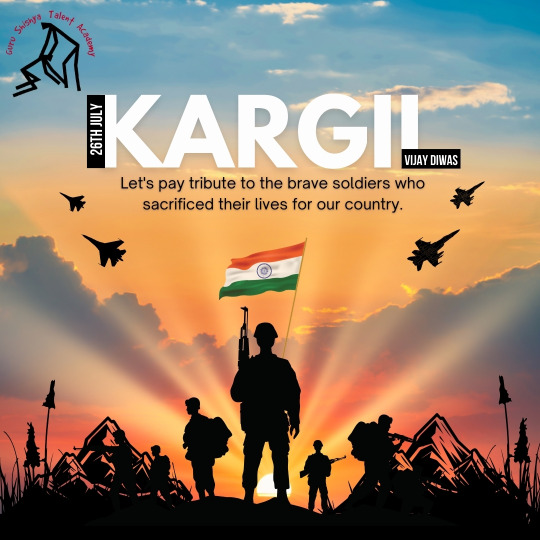
Kargil Vijay Diwas is celebrated on 26 July every year in honor of the soldiers who fought in the Kargil War. This day is celebrated all over India and in the national capital of New Delhi, where the Prime Minister of India pays homage to the soldiers at Amar Jawan Jyoti at the India Gate every year.
#gsta#gurushishyatalentacademy#gurushishya#talentacademy#guru#shishya#talent#academy#vandematram#bsf#bharatmatakijai#crpf#paracommando#cisf#indianflag#indianarmyfans#jayhind#iloveindia#crpfjawans#kargilday#kargilvijaydiwas#war#soldiers#bangalore#garvebhavipalya#happy#skills#classes#development
0 notes
Text
Top 7 Best Places To Visit in Delhi
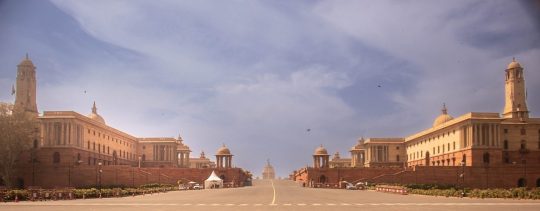
Located on the vast banks of the Yamuna River, Delhi, the capital of India represents a distinct fusion of ancient and contemporary cultures. Explore the best places to visit in Delhi unraveling its diverse cultural legacy and historical landmarks reflecting the city's dynamic social structure and lifestyle. The city chronicles the history of the various civilizations and dynasties that flourished here for over 3000 years. Their legacy survives in the many ancient monuments left behind by their rulers, each a chronicle of the glory of its times and a reflection of the prevailing cultures. Here are the remnants of seven different capital cities. Here is a pick of the Top 7 Best Places To Visit in Delhi:
1. Qutub Minar, Delhi
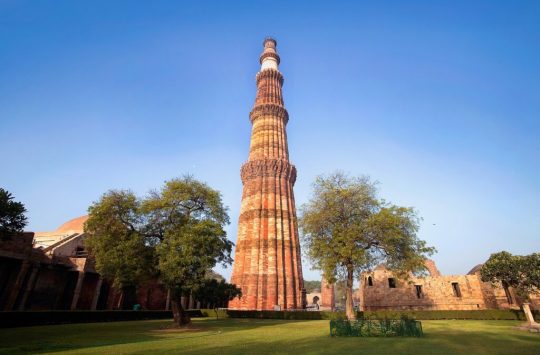
Image Courtesy: Pixabay Qutub Minar, one of Delhi’s oldest monuments, stands tall as a testament to history, making it one of the best places to visit in Delhi. A mammoth minaret (238 feet tall) built from the remains of 27 Hindu and Jain temples during the years 1193–1369, commemorating the victory of Qutab-ud-din over the city's last Hindu kingdom, Qutub Minar is one of Delhi’s oldest monuments. Decorated with calligraphy representing verses from the Koran, it tapers from a 50-foot diameter at the base to just 8 feet at the top. The first three floors are built with red sandstone, and the upper two with white marble. In the same complex stands a mysterious Iron Pillar, bearing fourth-century Sanskrit inscriptions from the period of King Chandragupta II, that has intrigued scientists to no end because it has withstood centuries of climatic upheavals and remained rust-free till today. A popular legend says that if you can encircle it with your arms while standing with your back touching it, any wish will be fulfilled.
2. Red Fort, Delhi
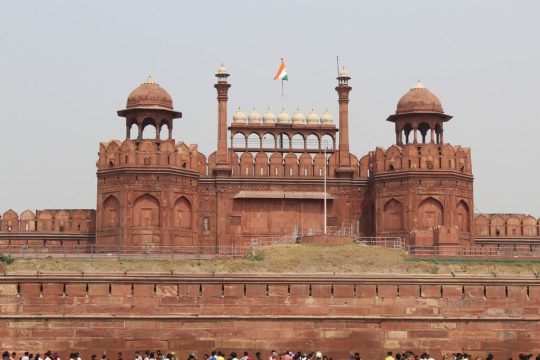
Image Courtesy: Pixabay Popularly known as Lal Quila and built by Shah Jahan in the years 1618–1647, Red Fort, with its massive sandstone walls and exquisite architecture, is the ultimate reminder of the sheer wealth, splendor, and power of the Mughal Empire. There are many must-see places within the fort, resplendent with intricate decoration, with separate rooms and balconies for the womenfolk, swimming pools, and natural air conditioning. It also houses an Archaeological Museum.
3. Jantar Mantar, Delhi

Constructed in 1724 by Maharaja Sawai Jai Singh II, this observatory is among the best places to visit in Delhi. This esoteric, awe-inspiring salmon-colored stone-and-brick structure is an observatory used by the king for measuring time and calculating the positions of the stars and planets, and for prediction of eclipses. It houses multiple buildings with unique architectural combinations of geometrical forms, each meant for a specialized purpose of astronomical measurement. Also Read: THRILLING PLACES TO VISIT IN NOIDA IN 2024
4. Purana Qila (Old Fort), Delhi
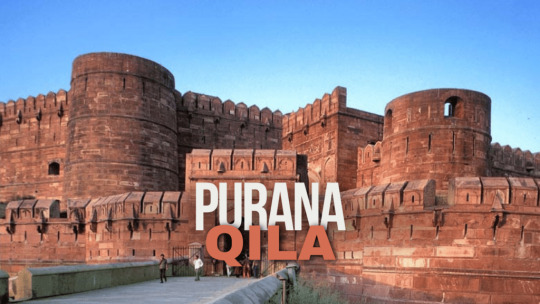
Believed to have been built on the ruins of the ancient original city of Delhi (Indraprastha, founded in the 3rd or 4th century B.C.), by the Afghan ruler Sher Shah during the years 1538–1545, the Old Fort with its massive walls and three imposing gateways gives a fair idea of its lost grandeur. It houses a small octagonal red sandstone tower, used by King Humayun as a library, the Qila-i-Kuhran Mosque, and a small archaeological museum.
5. India Gate, Delhi
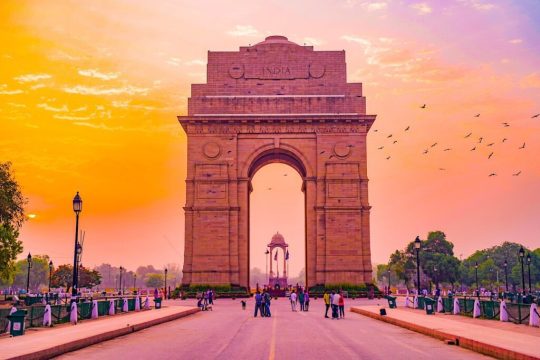
Image Courtesy: Pixabay India Gate, one of the best places to visit in Delhi, honors the seventy thousand Indian soldiers who gave their lives in battle against the foreign adversaries in World War I. It was created by Edwin Lutyens and features the immortal Amar Jawan Jyoti, also known as the Flames of the Immortal Soldier, which was incorporated afterward to honor the Indian martyred troops in the Indo-Pak War. Moreover, this exquisite work of art is regarded as one of India's biggest military memorials. The building, which is set atop a stone foundation from Bharatpur, is encircled by verdant gardens and is a well-liked location for picnics in the summer and winter. When the monument is illuminated at night, the surrounding colorful fountains provide a stunning sight.
6. Akshardham Temple, Delhi

India's cultural heritage is eloquently displayed in the Swami Akashar Dham temple, which epitomizes the country's old grandeur and beauty. A trip to the temple offers you an enlightening journey through the eternal spiritual teachings, unique values, and magnificent art of India. Discover the magnificence of India's art and architecture, as well as its culture and spirituality, as you visit the enormous temple structure with its lotus-shaped garden, beautiful green meadows, and exquisite bronze statues. In the evening, take in the magnificent musical fountain performance.
7. Parathe Wali Gali, Delhi
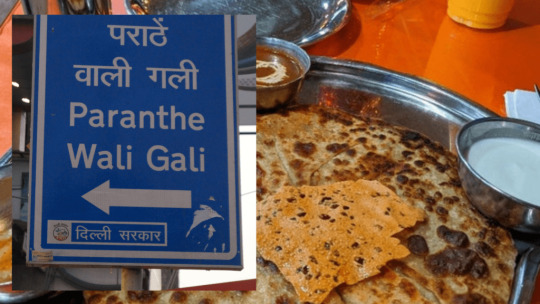
In the heart of Old Delhi's vibrant market district, Chandni Chowk, discover Paranthe Wali Gali—one of the best places to visit in Delhi. This area is well-known for its stores and food stands offering an extensive selection of mouthwatering-filled parathas. These parathas can be filled with potatoes, paneer, lentils, and a variety of other ingredients. With roots in the Mughal Empire, Paranthe Wali Gali boasts a long history. There are numerous paratha options on the street to suit a variety of palates. While some stores focus on classic stuffing, others play around with fusion and contemporary ingredients.
Conclusion
India's capital, Delhi, is a city that combines the best aspects of ancient and modern cultures. It has a rich past. Numerous historic sites and monuments document the city's rich cultural heritage. The top 7 best places to visit in Delhi include Qutub Minar, Red Fort, Jantar Mantar, Purana Qila, India Gate, Akshardham Temple, and Parathe Wali Gali. These attractions offer a glimpse into the city's glorious past, architectural marvels, and culinary delights. FAQ's Q1) What is Delhi best known for?Ans) Delhi is well-known for its cuisine, markets, and tourist attractions. Since it is the nation's capital, you can visit India Gate and Red Fort.Q2) Which places to visit in Delhi are listed on UNESCO?Ans) You can visit Qutub Minar and Red Fort, as these two historical places in Delhi have been listed as UNESCO World Heritage Site.Q3) What are the top spots in Delhi for taking pictures?Ans) The best places in Delhi for taking pictures are Qutub Minar, India Gate, Jantar Mantar, and Akshardham Temple. Read the full article
0 notes
Text
Top 10 Places to Visit in Delhi
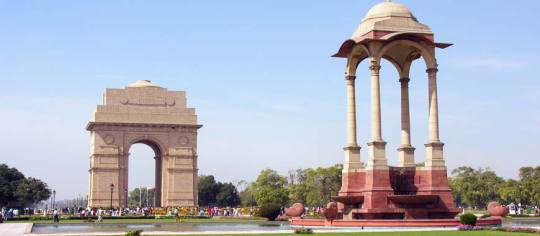
Delhi, the capital city of India, is a fascinating blend of rich history, vibrant culture, and modern development. With its diverse attractions, Delhi offers a myriad of experiences for every type of traveler. Whether you are a history enthusiast, a food lover, or someone seeking spiritual tranquility, Delhi has something for everyone. A tourist visiting the national capital of India must explore the top 10 places to visit in Delhi, each offering a unique glimpse into the city's multifaceted charm.
Red Fort (Lal Qila): The iconic Red Fort, a UNESCO World Heritage Site, stands as a majestic symbol of India's rich past. Built by the Mughal Emperor Shah Jahan in the 17th century, this colossal red sandstone fortress served as the main residence for Mughal emperors for nearly 200 years. The intricate architecture, including Diwan-i-Aam and Diwan-i-Khas, reflects the grandeur of the Mughal era. A visit to the Red Fort is a journey through history, with its stunning structures and well-maintained gardens.
Qutub Minar: Qutub Minar, another UNESCO World Heritage Site, is the world's tallest brick minaret and an exemplary masterpiece of Indo-Islamic architecture. Built in the early 13th century by Qutub-ud-din Aibak, the first ruler of the Delhi Sultanate, the minar is surrounded by ancient ruins, including the Quwwat-ul-Islam Mosque. The intricate carvings on the minaret and surrounding structures make it a must-visit for history and architecture enthusiasts.
India Gate: India Gate, an iconic war memorial, honors the soldiers who sacrificed their lives during World War I. This majestic arch stands at the heart of New Delhi and is surrounded by lush lawns, making it a popular spot for picnics and evening strolls. The Amar Jawan Jyoti, an eternal flame, burns in memory of the unknown soldiers, adding a solemn touch to the impressive structure.
Humayun's Tomb: Humayun's Tomb, another UNESCO World Heritage Site, is a stunning example of Mughal architecture and a precursor to the Taj Mahal. Built in the mid-16th century, this tomb is the final resting place of the Mughal Emperor Humayun. The symmetrical garden layout, intricate lattice work, and use of red sandstone showcase the Mughal aesthetic at its peak, making it a serene and visually captivating destination.
Lotus Temple: The Lotus Temple, a Bahá'í House of Worship, is renowned for its distinctive lotus-shaped architecture and its message of unity and peace. Surrounded by lush gardens, the temple is open to people of all faiths and beliefs, providing a tranquil space for meditation and contemplation. The architectural marvel and the serene atmosphere make the Lotus Temple a unique and spiritually enriching experience.
Akshardham Temple: Akshardham Temple, a relatively modern marvel, is a sprawling complex dedicated to showcasing Indian art, culture, and spirituality. The intricately carved central monument, surrounded by the Yagnapurush Kund, reflects traditional Indian craftsmanship. The Sahaj Anand Water Show and the cultural boat ride are must-see attractions within the complex, offering a multimedia and immersive experience.
Jama Masjid: Jama Masjid, one of the largest mosques in India, is an architectural marvel built by the Mughal Emperor Shah Jahan. Completed in 1656, the mosque's grand courtyard can accommodate thousands of worshippers. Climbing the minaret provides a breathtaking panoramic view of Old Delhi, offering a glimpse into the city's historical and cultural tapestry.
National Museum: For those interested in India's rich cultural heritage, the National Museum is a treasure trove of artifacts spanning over 5,000 years. The museum houses a vast collection of sculptures, paintings, decorative arts, and archaeological finds, providing a comprehensive overview of India's artistic and cultural evolution. From ancient civilizations to modern art, the National Museum offers a fascinating journey through time.
Gurudwara Bangla Sahib: A spiritual oasis in the heart of Delhi, Gurudwara Bangla Sahib is one of the most prominent Sikh shrines. The shimmering Sarovar (pond), the soothing Kirtan (devotional music), and the community kitchen serving free meals (Langar) create a serene and inclusive atmosphere. Visitors of all faiths are welcome, making it a symbol of harmony and unity.
Dilli Haat: Dilli Haat is a vibrant cultural and shopping destination that showcases the diversity of India's handicrafts and cuisine. This open-air market features stalls representing various states, offering a wide array of traditional handicrafts, textiles, and regional delicacies. The lively ambiance, cultural performances, and the opportunity to interact with artisans make Dilli Haat a delightful and immersive experience. Delhi, with its kaleidoscopic blend of history, culture, and modernity, invites travelers to explore its myriad facets. Each of these top 10 places contributes to the city's allure, offering a unique perspective on Delhi's rich tapestry. Whether you are wandering through ancient monuments, savoring diverse cuisines, or finding solace in spiritual havens, Delhi promises a journey of discovery and wonder. Optima Travels offers several Delhi day tour packages.
0 notes